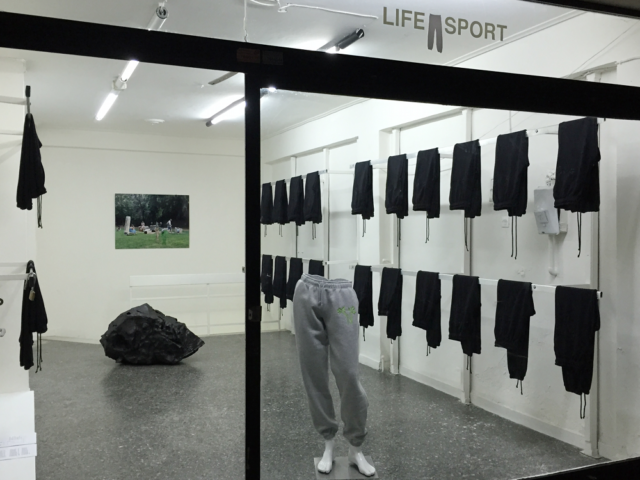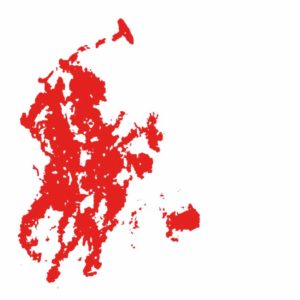For many contemporary artists, the notion of a lucrative art practice is an oxymoron. With it one becomes accustomed to perpetual labour, a mix of both paid and unpaid work, where everyone becomes burnt out. But there appears to be something interesting emerging from between the polarized economic model of being either successful or’unsuccessful’ as an artist; a desire for a more horizontal redistribution of wealth and to find financial autonomy from the institutional gatekeepers of an industry. The white-washed elephant in the room is the fact that the hierarchy of accomplishment is a biased one, steeped in structural violence. It comes as no surprise, then, that the evolution of making (for some) is in some ways attempting to sever the umbilical cord by producing and selling their own products.

Making merchandise is obviously not a new concept, especially for those who are in the ‘business’ of spreading a message rather than a product. Artist/activist group Guerilla Girls have been selling affordable objects to support their cause since 1985. To acquire some form of monetary control, alternative income is a necessary tool for activists and under-represented artists. But it’s also a strategy employed in other contexts, from the gift shops and artist editions of larger institutions like ICA and MoMA PS1 (Zabludowicz Collection sells shoes and pins, jackets and vinyl records) to the work of successful artists critqueing capitalism.
Thinking back to the irony of Ryan Trecartin + Lizzie Fitch’s $78 Abercrombie Night Vision Sweatshirt, there seems to be a departure from the language of tongue-in-cheek gestures and towards a direction that is less self-serving. The commercial art world is uncomfortable and problematic. Institutions often exploit free labour in return for prestige, and arts funding applications require a lot of time and an administrative expertise that many artists just don’t have. In what often feels inaccessible, this climate of exclusion is creating an interesting backdrop against which people are engaging in a sincere exploration of how to support and maintain a sustainable practice.

The idea of ‘merch’ is for artists to create products to support and promote themselves, but at what point does ‘art’ become merchandise (and vice versa). Is it simply down to the price tag? Does this question even matter anymore? As we know, categories of making are continually bleeding into one another, and the distinction between ‘genres’ is becoming irrelevant.
There isn’t one method or definition, and the line is blurry when sold in editions (if the supply ends, the product will inevitably become more precious, making for a potential rise in value, regardless of the cheap price it was initially sold at). And while none of these modes are fully-fledged businesses — or the ideal answer to the problem of income — they are engaging with what feels like a fresh spin, the starting point of a real shift from status quo. Here’s to what happens next.
Below are some examples, in no particular order, of some of the ways ‘merch’ is being actualized by artists:

The Toronto-based artist’s dog tag (2016) series was sold via her Instagram account for $30 each, but with only 50 editions. The work is categorized as ‘editions’ among others on her site and includes a s&h as well as a “signed and numbered certificate of authenticity”.
The London-based artist sells a range of prints, hats, socks, stickers among others things. Her work explores gender and ethnicity through digital media, welcoming negotiations and discussions to foster a flexible relationship with the buyer. Mattu explores the idea of commissions in that “some of it can be designed, recreated and sold in any which way somebody may want it.”
For her upcoming show Belladonna’s Muse, opening March 17 at Rome’s Basement Roma CURA, the London-based artist will be selling (quite cheaply) pearl necklaces made by grandmothers in the community to go alongside the exhibition. She refers to them as trinkets and plans to make them unlimited and made-to-order on site.
A highly skilled potter and contemporary artist described by curator Kate Neave as having an “expanded ceramic practice,” the London-based artist explores the the relationship between art and function. The way these objects can be extended to the social, where you can purchase pieces from his website which often sell in a limited amount related to a current project.

A New-York-based multimedia artist who sells sweatshirts, key rings, and more off her website. Santana’s products are scattered throughout her Tumblr-style website, taking away any category or hierarchy of making.
The Tucson-based video artist and poet successfully lives off selling T-shirts and books through the publishing project he started called Boost House. Most importantly, he uses crowdfunding website Patreon which allows his fans to donate a small amount for each video he makes. You can ready more in our recent interview with him where he talks about the importance of keeping his work free on Youtube. His Patreon supporters are often sent postcards and given personalised videos to keep in touch. Just like charity, acquiring money is always more successful through exchange: I’ll give you money as long as I know you’re going to run a marathon.
“They’re not merchandise and not quite artworks either. They’re something in between,” says Samia Mirza of the bi-coastal art and production duo, including Justin Swinburne, about a range of silk scarves, featuring any number of appropriated images that make up their audio-visual oeuvre. “We’re making these things that happen to exist in these realms,” she adds in a 2014 interview with aqnb about selling clothing and accessories, in an act that’s as much a part of their practice as it is an income.

The music and artist project by Berlin-based artist Daphne Ahlers and Vienna-based artist Rosa Rendl, recently sold merchandise at Vienna’s Kurzbauergrasse for performance ‘Shortest Way to Confidence.’ While Lonely Boys is a band that produces merchandise, they still stand suspended between the realms of visual art and music, producing and performing in gallery spaces for events like 3hd Festival, and with the likes of fellow artist Philipp Timischl.
The London-based artist has both a craft-based and contemporary art practice, often bringing the two together in performance and installation. Inspired by racing girls, drag artists and hen nights, the current collection is called Hyperfemme and is “to be worn by anyone of any gender who wants to look femme as fuck.”

The anonymous collective sell sweatpants out of their gallery in Athens, recently opening a ‘shop’ in Berlin, with all proceeds directly support the exhibitions put on in the space. In a recent interview, aqnb spoke with LIFE SPORT about their reasons for selling sweatpants and the difficulty of getting funding as a nomadic project.**















